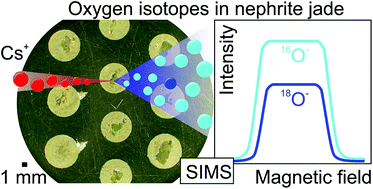Sensitive and rapid oxygen isotopic analysis of nephrite jade using large-geometry SIMS†
Abstract
Nephrite jade is a rare and highly prized rock consisting mainly of finely intergrown amphibole of tremolite-actinolite composition which has been culturally used from the Paleolithic to modern times. Understanding and tracing its provenance is key for solving geological, archaeological, and gemmological problems. Previous approaches to identify nephrite sources utilized a wide range of visual, spectroscopic, and geochemical methods (based on analysis of major elements, trace elements, or isotopes), but these approaches are often limited by their discriminatory power, destructiveness, and/or analytical throughput. Here, we introduce O-isotopic analysis of nephrite using secondary ion mass spectrometry (SIMS) which affords superior spatial resolution and speed compared to other isotopic methods. By analysing a large number (n = 56) of geological samples from nephrite-bearing regions in the vicinity of Lake Baikal in southern Siberia, Russia, we assess intra- and inter-specimen heterogeneity and test the sensitivity of O-isotopes to discriminate the provenance regions for nephrite. Intra-sample variability at the centimetre scale is ≤0.8‰, and typically less at the sub-millimetre scale when sampled by multiple ion beam spots ∼20 μm in diameter and with a depth resolution of few μm. Accurate SIMS analysis of nephrite requires correction for matrix-dependent instrumental mass fractionation, for which we developed an empirical calibration based on Mg + Ca cation allocation on the crystallographic B-site of amphibole. Ranges in SIMS δ18O for individual nephrite-bearing regions are +3.98 to +8.04‰ (East Sayan; n = 36), +5.21 to +11.76‰ (Dzhida; n = 13), and −17.16 to −22.95‰ (Vitim; n = 7). These results indicate that SIMS O-isotope analysis permits rapid discrimination not only for nephrite of different geologic origins (serpentinitic ultramafic or S-nephrite from East Sayan and Dzhida vs. dolomitic carbonate or D-nephrite from Vitim), but also for distinct geographic provenance of the same nephrite type (S-type nephrite from East Sayan vs. Dzhida regions).



 Please wait while we load your content...
Please wait while we load your content...